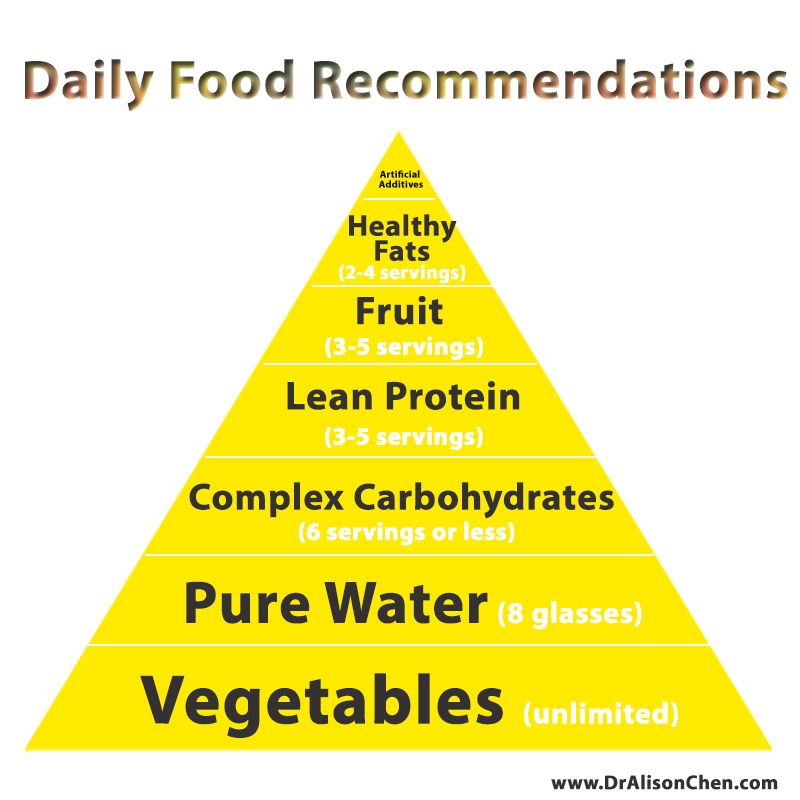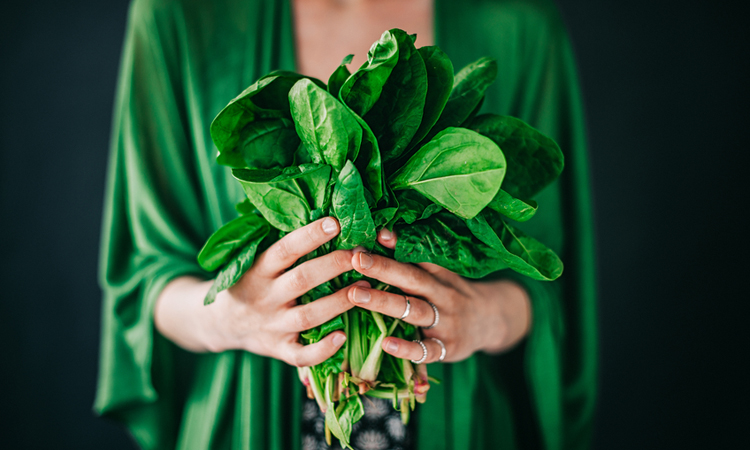“Eat foods that nourish your body and soul. Treat your body with the respect and care it deserves.” –Rose Caiola
Are you tired of being told what you once thought was healthy is now bad for you?
It’s frustrating to go from one extreme diet to another, constantly worried about what you should and shouldn’t be eating. Have you ever noticed there is only one constant to any fad diet, weight loss plan or nutrition regiment?
Vegetables. And lots of them.
Most diets focus on the minutia, such as:
- When to eat carbs
- How to couple food groups
- Portion control
- Calorie timing
- What foods to avoid
- How to make substitutions for your favorite meals
But what’s missing in these dietary tactics is the emphasis of eating veggies.

Your daily diet should look something closer to the new food pyramid above, with the most important emphasis on vegetables. To clarify, that’s unlimited amounts of leafy greens and colorful vegetables with one to three portions of root vegetables per day.
Why limit root vegetables?
Root vegetables are packed with important nutrition, but also starches. Your body uses starches for energy, just like carbohydrates from bread and sugars from fruit.
Starches, carbohydrates and sugars are crucial for the body to create energy. But when eaten in high amounts over a short period of time, they can lead to sugar spikes in your blood, followed by a state of hypoglycemia and inflammation. This may be why you feel sleepy after a big meal of pasta or have brain fog after the sugar high of your afternoon donut. Heavy starch vegetables include anything grown underground – carrots, potatoes, sweet potatoes, yams, radish, turnip and taro – but also corn, pumpkin and squash.
But it’s important to keep the big picture in mind.
If you have the choice between a donut or a bag of baked root vegetable chips, the choice should be obvious.
Don’t drive yourself crazy with the minutia. Make educated and wise food choices. When you are going to indulge in a non-nutritious food, make sure you enjoy it, and save yourself the guilt trip.
Remember that the most successful diet is the one you can actually stick to. The general 80:20 rule of thumb may be the easiest plan you can have. Even so, the 80:20 rule is simple, but not always easy. Eighty percent of the time, plan for nutritious meals and eat mindfully. The other 20 percent of the time, enjoy your favorite foods with pleasure.
A majority of the healthy 80 percent should be vegetables.
Why Vegetables?
Vegetables are the best diet food and preventative medicine for any condition. Best of all, they are affordable and accessible. They are high in vitamins, minerals and fiber while low in calories. Many have valuable antioxidant, anti-inflammatory and immune supportive properties to combat predisposing factors of cancer, heart disease, immune dysfunction and neuro-degenerative conditions.
Raw with the Peel
The most nutritious way to eat your veggies is raw with the peel on. This form allows the greatest amount of nutrients and fiber to be absorbed, however, some people may have difficulty digesting raw vegetables, so steamed or stewed would be the next best option.
There is another group of people who are hypersensitive to certain foods, including vegetables, or have conditions that are worsened by specific types of foods. For example, interstitial cystitis (IC or hyperactive bladder condition) is worse with acidic foods, such as tomatoes.
Speak with your Naturopathic doctor if you think specific food groups might affect you.
Many vegetables are also superfoods and super greens because they are highly nutrient dense foods.
Superfoods vs Super Greens
Superfoods are natural foods that contain especially high nutrient content per serving. They are jam-packed with disease-fighting power, and most include vegetables and fruits. These are the foods to focus on when planning your meals for yourself and your family.
The top superfoods and their nutritional content include:
- Sprouted wheat grass – high amounts of chlorophyll (70 percent) increases oxygen-blood-iron circulation to supports thyroid, digestive and blood glucose regulation.
- Broccoli and broccoli sprouts – rich in amino acids, vitamin K and anti-cancer properties
- Spinach – a potent source of vitamins and minerals, especially iron and manganese
- Kale – this high fiber and slightly bitter leafy green is packed with vitamins, minerals and calcium, as an effective anti-oxidant
- Seaweed (wakame, nori, dulse, kelp) – an alkalyzing anti-oxidant with a strong ability to chelate and purify the blood, not to mention a high source of iodine
- Blueberries – strong antioxidant, anti-inflammatory and high in vitamin C
- Salmon and omega 3 fish oils – the high EPA levels in omega-3 fish oils are ideal for anti-inflammatory, cognitive and cardiovascular support
- Tea (green or black) – strong antioxidant, anti-inflammatory, anti-microbial, anti-diabetic and provides support for metabolic and neurological activities. Do you know the difference between various caffeine products?
- Goji berries – very high in vitamin C with anti-oxidant properties
- Raw Cacao – strong anti-oxidant, high in magnesium and non-heme iron
- Tumeric – potent anti-inflammatory and anti-microbial agent, used in many countries as a heart protective spice and natural food preservative
- Coconut (young) – coconut water, milk and the oils are all so nutritious. Coconut water is a potent electrolyte replacement, and the medium-chain fatty acids are healthy to cook with for cognitive support or as a natural lubricant, anti-microbial and sunscreen
- Dark chocolate (at least 70 percent) – cocoa is a strong anti-oxidant and can lower blood pressure
- Unpasteurized honey and propolis – high in protein and as a natural anti-microbial, to be used externally and internally, except with infants and pregnant women
As you can see, a number of these super foods are vegetables because of their highly nutritious content. Now let’s take a look at nutrient dense greens:
Super Greens are commonly powdered forms of condensed vegetables or algae. I love using them as a supplemental boost to my diet. It’s especially useful for my busy mornings, when I may not be able to make a well-balanced meal and can prepare a healthy morning shake with my super greens.
I alternate my sources of greens after each container to ensure I’m getting a variety of nutrition. My favorites sources are:
- Chlorella – fresh water algae with a complete protein profile, with immune and cardiovascular supporting properties
- Spirulina – a cultivated micro-algae, with high levels of protein and anti-diabetic properties
- Sprouted wheat grass – high amounts of chlorophyll (70 percent) increases oxygen-blood-iron circulation to supports thyroid, digestive and blood glucose regulation.
- Barley grass – high in calcium, non-heme iron and vitamin C
- Wild blue-green algae – a phyto-plankton high in protein, with immune supporting functions
What are SPROUTS?
Sprouts are also a good food source because of how jam-packed they are with nutrition. Sprouts are germinating seeds that eventually grow into plants, legumes, seeds, grains and vegetables. This means that the nutrients of the plant are concentrated into the germinating seed.
The most nutritious sprouts include:
- Chlorophyll-rich sprouts: wheat grass, sunflower, buckwheat lettuce, snow pea shoots
- Small vegetable seeds: alfalfa, clover, arugula, broccoli, kale, cabbage, fenugreek
- Grains and seeds: amaranth, quinoa, millet, buckwheat, rye, spelt, teff
- Legumes: lentils, white beans, red beans, pinto beans, chickpeas, mung beans, adzuki beans
To get the most nutrition out of your sprouts, make sure the seedling is germinating, and eat them raw. However, be careful of the quality of sprouts, since some can carry harmful bacteria, such as Salmonella and E. coli. Always purchase your sprouts from reputable sources, keep refrigerated, and eat within a few days.
How do I get enough veggies?
To ensure you are getting eight to 12 or more servings of veggies per day takes a lot of conscious effort and good choices. The best way to keep your nutritional intake high with variety is to form the following healthy habits:
1. Start your morning with a super green shake. = two to three servings
2. Have at least two servings of veggies with lunch and dinner. = four servings
3. Have at least one vegetable snack a day. = one serving
- Dried seaweed snacks
- Raw carrots, celery, cucumber, broccoli, cauliflower, etc.
- Guacamole and veggies
- Vegetable juice or wheatgrass shot
4. Have at least one super food or veggie green per day. = one serving
5. Pre-cut veggies on a Sunday, and keep them in easy to access baggies or Tupperware to grab and go.
6. Try one new leafy green or colorful vegetable a week.
7. Keep it interesting, and don’t always have salads.
This article originally appeared on DrAlisonChen.com and is republished here with permission.



